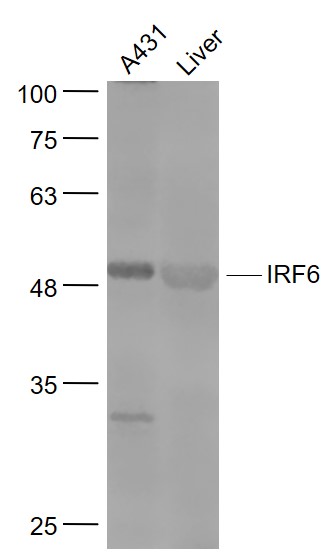
Rabbit Anti-IRF6 antibody
Interferon regulatory factor 6; IRF 6; IRF-6; IRF6_HUMAN; LPS; OFC 6; OFC6; OTTHUMP00000034677; OTTHUMP00000034678; PIT; PPS; PPS1; VWS; VWS1.
View History [Clear]
Details
Product Name IRF6 Chinese Name Interferon调节因子6抗体 Alias Interferon regulatory factor 6; IRF 6; IRF-6; IRF6_HUMAN; LPS; OFC 6; OFC6; OTTHUMP00000034677; OTTHUMP00000034678; PIT; PPS; PPS1; VWS; VWS1. literatures Research Area Cell biology Stem cells transcriptional regulatory factor Epigenetics Immunogen Species Rabbit Clonality Polyclonal React Species Human, Mouse, (predicted: Rat, Pig, Cow, Rabbit, Sheep, ) Applications WB=1:500-2000 ELISA=1:5000-10000
not yet tested in other applications.
optimal dilutions/concentrations should be determined by the end user.Theoretical molecular weight 53kDa Cellular localization The nucleus cytoplasmic Form Liquid Concentration 1mg/ml immunogen KLH conjugated synthetic peptide derived from human IRF6: 1-100/467 Lsotype IgG Purification affinity purified by Protein A Buffer Solution 0.01M TBS(pH7.4) with 1% BSA, 0.03% Proclin300 and 50% Glycerol. Storage Shipped at 4℃. Store at -20 °C for one year. Avoid repeated freeze/thaw cycles. Attention This product as supplied is intended for research use only, not for use in human, therapeutic or diagnostic applications. PubMed PubMed Product Detail Interferon regulatory factor-1 (IRF-1) and IRF-2 have been identified as novel DNA-binding factors that function as regulators of both type I interferon (interferon-alpha and beta) and interferon-inducible genes. The two factors are structurally related, particularly in their N-terminal regions, which confer DNA binding specificity. In addition, both bind to the same sequence within the promoters of interferon-alpha and interferon-beta genes. IRF-1 functions as an activator of interferon transcription, while IRF-2 binds to the same cis elements and represses IRF-1 action. IRF-1 and IRF-2 have been reported to act in a mutually antagonistic manner in regulating cell growth; overexpression of the repressor IRF-2 leads to cell transformation while concomitant overexpression of IRF-1 causes reversion. IRF-1 and IRF-2 are members of a larger family of DNA binding proteins that includes IRF-3, IRF-4, IRF-5, IRF-6, IRF-7, ISGF-3 gamma p48 and IFN consensus sequence-binding protein (ICSBP).
Function:
Probable DNA-binding transcriptional activator. Key determinant of the keratinocyte proliferation-differentiation switch involved in appropriate epidermal development (By similarity). Plays a role in regulating mammary epithelial cell proliferation.
Subcellular Location:
Nucleus. Cytoplasm. Translocates to nucleus in response to an activating signal.
Tissue Specificity:
Expressed in normal mammary epithelial cells. Expression is reduced or absent in breast carcinomas.
Post-translational modifications:
Phosphorylated. Phosphorylation status depends on the cell cycle and is a signal for ubiquitination and proteasome-mediated degradation.
DISEASE:
Defects in IRF6 are a cause of van der Woude syndrome (VWS) [MIM:119300]; also known as lip-pit syndrome (LPS). It is an autosomal dominant developmental disorder characterized by lower lip pits, cleft lip and/or cleft palate. Penetrance is incomplete. Van der Woude and popliteal pterygium syndrome are allelic disorders.
Defects in IRF6 are the cause of popliteal pterygium syndrome (PPS) [MIM:119500]. PPS is an autosomal dominant developmental disorder characterized by cleft lip and/or cleft palate, and skin and genital anomalies. Penetrance is incomplete and expressivity is variable. It shows orofacial phenotypic similarities with van der Woude syndrome. Van der Woude and popliteal pterygium syndrome are allelic disorders.
Genetic variation in IRF6 is associated with non-syndromic orofacial cleft type 6 (OFC6) [MIM:608864]; also called non-syndromic cleft lip with or without cleft palate 6. Non-syndromic orofacial cleft is a common birth defect consisting of cleft lips with or without cleft palate. Cleft lips are associated with cleft palate in two-third of cases. A cleft lip can occur on one or both sides and range in severity from a simple notch in the upper lip to a complete opening in the lip extending into the floor of the nostril and involving the upper gum.
Similarity:
Belongs to the IRF family.
Contains 1 IRF tryptophan pentad repeat DNA-binding domain.
SWISS:
O14896
Gene ID:
3664
Database links:Entrez Gene: 3664 Human
Entrez Gene: 54139 Mouse
Entrez Gene: 393570 Zebrafish
Omim: 607199 Human
SwissProt: O14896 Human
SwissProt: P97431 Mouse
Unigene: 591415 Human
Unigene: 719361 Human
Unigene: 273695 Mouse
Product Picture
References (0)
No References
Bought notes(bought amounts latest0)
No one bought this product
User Comment(Total0User Comment Num)
- No comment



 +86 571 56623320
+86 571 56623320
 +86 18668110335
+86 18668110335

